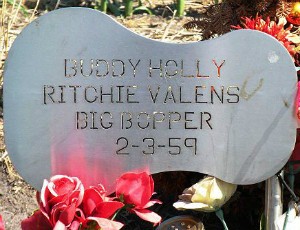For Throwback Thursday, we’re going back to February 3, 1959, “The Day the Music Died,” when Buddy Holly, Ritchie Valens and J.P. “The Big Bopper” Richardson, along with their pilot, were killed in a plane crash in Iowa. After the musicians endured numerous colds, flus and freezing bus rides while on tour, Buddy Holly decided to charter a plane to their next show. They took off at night under unfavorable weather conditions, and the plane subsequently crashed. The Chicago Tribune covered the accident, as did most major news outlets.
The event became known as “The Day the Music Died” when Don McLean released “American Pie” in 1971, which references the crash in the lyrics. The loss of the three young rock ‘n' roll musicians was significant. J.P. “The Big Bopper” Richardson’s 1958 version of “Chantilly Lace” was very popular. Ritchie Valens, the first Latino star of rock ‘n' roll in the United States, reworked the Mexican folk ballad “La Bamba” into a rock ‘n' roll hit. And Buddy Holly, despite his short career, had a lasting impact on rock ‘n' roll music. AllMusic states in his biography, “Holly became the single most influential force in early rock ‘n' roll.” Check out the self-titled Buddy Holly, which was released the year before his death.
Although some promising musicians were lost, 1959 was a watershed year, argues Pulitzer Prize-winning journalist Fred Kaplan in his book 1959. Kaplan covers many significant events that took place in 1959 including the following:
Miles Davis recorded Kind of blue, which is considered by many to be the greatest jazz record of all time, and its influence reached beyond jazz music.
Grove Press published an uncensored version of Lady Chatterley's Lover. Copies of the book were confiscated by the United States Post Office. Grove sued and, thankfully, won the case, making the book, with its controversial sex scenes, available in the United States.
Berry Gordy, Jr. founded Motown Records.
Texas Instruments introduced the integrated circuit, a precursor to the modern computer, at a trade show.
The beat generation was in full swing, and American indie film trailblazer John Cassavetes’ first film, Shadows, was shown in New York City.



Add a comment to: #TBT: The Day the Music Died